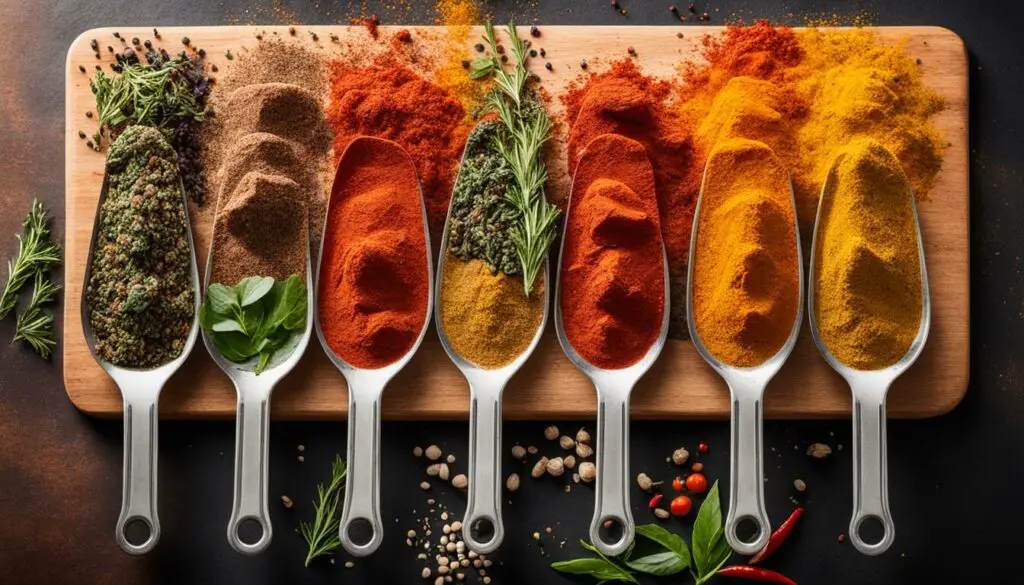Have you ever wondered how to take your BBQ dishes to the next level? How can you enhance the flavors of grilled meats, vegetables, and even cocktails with a touch of smoky goodness? Discover the art of experimenting with smoke flavor profiles and become a true BBQ master.
By exploring different smoking techniques, flavor infusion methods, and even smoke seasoning experiments, you can uncover unique and delicious smoke flavor combinations. From mastering smoke density and duration to understanding the influence of different wood varieties, there’s a whole world of smoke flavor exploration waiting for you.
In this article, we’ll delve into the science behind smoke and flavor, uncover pitmaster techniques for optimal smoke flavor, and even explore the sensory experience of smoke flavor. Get ready to challenge common beliefs, push the boundaries of traditional smoking, and unlock the secrets of smoke flavor profiles.
Table of Contents
ToggleKey Takeaways:
- Experimenting with smoke flavor profiles can elevate the flavors of your grilled dishes.
- Exploring different smoking techniques and flavor infusion methods leads to unique smoke flavor combinations.
- Understanding the science behind smoke and flavor helps in creating harmonious flavor profiles.
- Pitmaster techniques and equipment play a crucial role in achieving optimal smoke flavor.
- The sensory experience of smoke flavor goes beyond just taste, engaging all the senses.
The Science of Smoke and Flavor
To understand smoke flavor profiles, it’s important to dive into the science behind smoke and flavor. Wood combustion plays a crucial role in creating flavorful smoke. By understanding the key temperature ranges in smoke generation, you can manipulate the intensity and characteristics of the smoke. Additionally, different woods have unique chemical compositions that result in distinct smoke flavors. By understanding these components, you can experiment with different wood varieties to achieve the desired flavor profile in your grilled dishes and cocktails.
| Wood Type | Chemical Composition | Smoke Flavor |
|---|---|---|
| Hickory | High in lignin and cellulose | Rich, sweet, and bacon-like |
| Mesquite | High in phenols and creosote | Strong and intense |
| Apple | High in sugars and acids | Subtle and fruity |
As the wood burns, it undergoes a series of chemical reactions that release volatile compounds into the smoke. These compounds, such as phenols and creosote, contribute to the unique flavor profiles associated with different wood varieties. The duration of smoke exposure and the temperature at which the wood burns also influence the composition and intensity of the smoke flavor.
Mastering Smoke Density and Duration
Mastering smoke density and duration is an essential skill for achieving the perfect smoke flavor in your grilled dishes. By understanding how to manipulate smoke density and duration, you can create a balance of flavors that will elevate your culinary creations.
Manipulating Wood Moisture and Oxygen Levels
Wood moisture and oxygen levels play a crucial role in controlling smoke density and duration. The moisture content of the wood can affect the amount of smoke produced, with drier wood typically producing more smoke. Adjusting the amount of oxygen available to the fire can also influence the intensity and duration of smoke. By experimenting with different wood moisture levels and adjusting the airflow, you can fine-tune the smoke density and duration to achieve the desired flavor profile in your grilled dishes.
Impact of Extended Smoke Exposure on Meats
Extended smoke exposure can have a significant impact on the flavor and texture of meats. The longer meats are exposed to smoke, the more pronounced the smoky flavor will be. However, it’s important to strike a balance to avoid overwhelming the natural flavors of the meat. The type of wood used, the cooking temperature, and the cooking time all contribute to the final result. By carefully monitoring the smoke exposure and adjusting the cooking parameters, you can enhance the flavor of your meats without overpowering them with smoke.
Experimenting with Smoke Flavor Profiles
Experimenting with smoke flavor profiles is all about getting creative and trying new combinations of woods, ingredients, and smoking techniques. By exploring different flavors and techniques, you can develop your own unique smoke flavor profiles that will impress your guests and elevate your grilling game. Don’t be afraid to step outside the box and experiment with unconventional smoke flavor combinations.
To get started, consider the following ideas for experimenting with smoke flavor:
- Mix and match different wood varieties to create complex smoke profiles.
- Infuse your smoking woods with herbs, spices, or fruits for added depth of flavor.
- Try smoking different types of meats, vegetables, and even fruits to explore how smoke enhances their natural flavors.
- Experiment with different smoking techniques, such as hot smoking, cold smoking, or smoke-roasting, to achieve varied results.
The possibilities are endless when it comes to smoke flavor experimentation. Let your imagination run wild and discover the incredible flavors that can be achieved by harnessing the power of smoke.
Remember, each smoke flavor profile is unique, and what works for one dish may not work for another. Keep a record of your experiments, take notes on the results, and refine your techniques over time. With patience and dedication, you’ll become a master at creating unforgettable smoke flavor profiles that will leave a lasting impression on anyone who tries your grilled creations. So go ahead, fire up the grill, and let the adventures in smoke flavor experimentation begin!
Wood Varieties and Their Distinct Smoke Signatures
Different wood varieties play a significant role in creating unique smoke flavor profiles for your grilled dishes. Each type of wood has its own distinct smoke signature, which can greatly enhance the taste and aroma of the food you are cooking. Understanding the characteristics of various wood varieties will help you choose the right ones to achieve your desired smoke flavor profile.
When it comes to smoking, one important distinction is between hardwoods and softwoods. Hardwoods, such as oak, hickory, and mesquite, are denser and burn at a slower rate. They produce a steady and consistent smoke that imparts a robust and rich flavor to your dishes. Softwoods, on the other hand, like pine and cedar, burn faster and generate a milder smoke flavor.
Another factor to consider is the origin of the wood. The type of wood used, whether it’s local or imported, can influence the smoke profile. Local woods may have unique flavors and aromas associated with the region, while imported woods may introduce unfamiliar notes to your dishes. Experimenting with different wood origins can add an exciting dimension to your smoke flavor exploration.
Did you know? Cherry wood offers a slightly sweet and fruity smoke flavor, making it a popular choice for smoking poultry and pork. On the other hand, apple wood provides a milder and sweeter smoke that pairs well with delicate meats like fish or chicken.
Blending Smoke with Your Barbecue Sauce
Blending smoke with your barbecue sauce can take your grilled dishes to a whole new level of flavor. By incorporating the distinct smoky taste into your sauce, you can create a harmonious fusion of flavors that will leave your taste buds wanting more.
Balancing Smoke Intensity with Sauce Ingredients
When blending smoke with barbecue sauce, it’s important to strike the right balance between smoke intensity and the other ingredients in the sauce. The smokiness should enhance the overall taste without overpowering or overshadowing the flavors of the sauce itself.
To achieve this balance, consider the intensity of the smoke flavor and adjust the amount of smoke added to the sauce accordingly. Start with a small amount and gradually increase it until you achieve the desired level of smokiness. This will ensure that the smoke flavor becomes a complementary element rather than the dominant note.
Smoke Flavor as a Complementary Element
Smoke flavor should be treated as a complementary element in your barbecue sauce, enhancing the overall taste of the sauce and the grilled dish. It should complement the other flavors present, such as the tanginess of the tomatoes or the sweetness of the honey, rather than overpowering them.
The key is to find a delicate balance between the smoke and the other ingredients. This can be achieved by carefully selecting complementary flavors that work well together. For example, a smoky barbecue sauce with a hint of sweetness can pair beautifully with grilled pork ribs, creating a mouthwatering combination of flavors.
Experiment with different smoke intensities and sauce ingredients to find the perfect balance that suits your taste preferences. Remember, the goal is to create a harmonious blend of flavors that tantalizes the palate and keeps you coming back for more.
Smoke Flavor Exploration in Cocktails
Smoke flavor exploration isn’t limited to just grilled dishes. It can also be incorporated into cocktails to create unique and intriguing flavor profiles. The art of infusing smoke into beverages involves using smoking guns or cloches to capture the essence of smoke and enrich the flavor of the drink.
Aromatics play a significant role in cocktails, acting as invisible taste modifiers that enhance the overall drinking experience. These aromatic elements can include herbs, spices, fruits, and even floral essences. By exploring smoke flavor in cocktails and carefully selecting complementary aromatics, you can create memorable and flavorful drinks that will delight your senses.
Infusing smoke into cocktails adds a captivating visual element and an extra layer of complexity to the flavor profile. With the use of smoking guns or cloches, the smoke is trapped in the glass, creating a visually stunning presentation and adding a hint of smoky aroma to every sip.
Additionally, the infusion of smoke into cocktails allows for endless creativity and experimentation. You can use different types of wood chips or herbs to produce unique smoke flavors that complement the ingredients in the drink. Some popular smoke-infused cocktails include smoky margaritas, smoked old fashioneds, and even smoky martinis.
It’s important to note that the intensity of the smoke can be adjusted to suit your personal preference. From subtle wisps to bold smoke clouds, the level of smokiness can be controlled to create the desired effect in your cocktails.
So, the next time you’re looking to impress your guests with a truly unique and delicious cocktail, consider venturing into the realm of smoke flavor exploration. Infusing smoke into your beverages and experimenting with aromatics will elevate your mixology skills and create unforgettable drinking experiences.
The Chemistry of Smoky Spirits
Smoky spirits, such as scotch and mezcal, have a distinct flavor profile that adds depth and complexity to cocktails. The chemistry behind smoky spirits involves exposing the grains or malts to smoke during the distillation process. This results in the absorption of smoky flavors that contribute to the unique taste of these spirits. By understanding the chemistry of smoky spirits, you can effectively incorporate them into your cocktails and create tantalizing flavor combinations.

When it comes to smoky spirits, the magic happens during the production process. As the grains or malts are being cooked and fermented, smoke from burning wood is introduced. The smoke acts as a flavoring agent, imparting its distinct characteristics to the spirits. The type of wood used for smoking can greatly influence the final flavor profile.
“The smoky flavors in scotch and mezcal come from the grains or malts being exposed to smoke during the distillation process.” – Expert
As the grains or malts are exposed to smoke, the complex compounds present in the wood interact with the alcohol molecules to create a unique chemical composition. These compounds, known as phenols, contribute to the smoky aromas and flavors found in scotch and mezcal. The amount of exposure to smoke and the type of wood used will determine the intensity and character of the smoky flavors.
When incorporating smoky spirits into cocktails, it’s important to consider the overall flavor profile of the drink. The smoky notes should complement and enhance the other ingredients, creating a harmonious and well-balanced cocktail. Whether it’s a classic whiskey sour with a hint of smoky scotch or a mezcal margarita with the distinct aroma of agave and smoke, the chemistry of smoky spirits adds a layer of complexity and intrigue to cocktails.
By understanding the chemistry behind smoky spirits, you can explore new flavor combinations and create unique cocktails that will impress your guests. The distinct flavor profile of smoky spirits adds depth and complexity to any drink, making them a valuable asset for mixologists and cocktail enthusiasts alike.
Pitmaster Techniques for Optimal Smoke Flavor
Pitmasters have honed their skills and developed techniques to achieve the perfect smoke flavor in their grilled dishes. With their expertise, they have learned the art of balancing flavors and controlling smoke to create mouthwatering results. Let’s explore some of the key pitmaster techniques for achieving optimal smoke flavor.
Fire Management Strategies for Consistent Results
One of the secrets to achieving optimal smoke flavor is effective fire management. Pitmasters understand the importance of controlling airflow and maintaining a steady temperature in the smoking chamber. By adjusting the airflow vents and using a combination of open and closed techniques, they can regulate the amount of oxygen available to the fire, resulting in a controlled burn that produces consistent smoke flavor.
Adding wood in a controlled manner is another crucial aspect of fire management. Pitmasters know that different woods produce different smoke flavors. They carefully choose their wood varieties and add them strategically throughout the smoking process to ensure a harmonious balance of flavors. By adding wood in small increments, such as using wood chips or chunks, they can control the intensity and duration of smoke, preventing overpowering flavors or excessive bitterness.
The Role of Equipment in Smoke Flavor Control
In addition to mastering fire management, pitmasters understand that equipment plays a vital role in controlling and enhancing smoke flavor. Smokers and grills designed specifically for smoking offer features that allow for precise temperature control and smoke circulation. By investing in high-quality smokers with built-in thermometers, adjustable vents, and smoke baffles, pitmasters can fine-tune the smoking process to achieve optimal smoke flavor.
Furthermore, pitmasters utilize different equipment and accessories to enhance smoke flavor. For example, using a water pan in the smoking chamber can help regulate temperature and add moisture to the smoke, resulting in juicier and more flavorful dishes. Additionally, utilizing smoking pellets or chips made from specific wood varieties can provide a more pronounced and desired smoke flavor. With the right equipment and tools at their disposal, pitmasters have the ability to control and enhance smoke flavor to perfection.
Enhancing Grilled Dishes with Smoked Spices
One of the most exciting ways to elevate the flavor of your grilled dishes is by enhancing them with smoked spices. When combined with the delectable smoky flavors from your grill or smoker, these seasonings add a whole new dimension to your cooking. Crafted using a variety of aromatic spices, these smoky rubs and marinades infuse your meats and vegetables with irresistible flavors.
Crafting Smoky Rubs and Marinades
Creating your own smoky rubs and marinades allows you to tailor the flavors to your taste preferences. By combining ingredients like smoked paprika, cumin, garlic powder, and brown sugar, you can achieve a well-balanced blend that enhances the natural flavors of the food while adding a smoky depth. These rubs can be massaged onto meats before cooking or used as a dry marinade to infuse the flavors overnight.
For marinades, you can blend smoked spices with other ingredients like olive oil, apple cider vinegar, and Worcestershire sauce to create a flavorful liquid that tenderizes and flavors your meats. The longer you marinate, the more intense the smoky flavors will be. It’s best to experiment with different combinations and ratios to find your perfect balance.
Merging Smoke with Heat in Grilled Recipes
When it comes to enhancing grilled dishes, it’s all about finding the delicate balance between smoke and heat. The smoky flavors from your grill or smoker should complement the natural flavors of the food and not overpower them. By merging smoke with heat in your grilled recipes, you can achieve a harmonious combination of flavors and textures.
For example, you can start by grilling your meats over high heat to create a flavorful crust and seal in the juices. Then, you can move them to a lower heat or indirect heat area of the grill to allow the smoky flavors to penetrate the meat. This technique ensures that the smoky essence is infused throughout the dish while still maintaining its juiciness and tenderness.

| Smoked Spice | Flavor Profile | Recommended Pairings |
|---|---|---|
| Smoked Paprika | Rich, smoky, and slightly sweet | Grilled chicken, roasted vegetables, marinades |
| Smoked Cumin | Warm and earthy with a subtle smokiness | Grilled lamb, Mexican dishes, spice rubs |
| Smoked Garlic Powder | Intense and bold with a smoky kick | Steak, roasted potatoes, barbecue sauces |
| Smoked Brown Sugar | Caramelized and smoky sweetness | Grilled pork, baked beans, glazes |
Experimenting with different combinations of smoked spices and techniques is key to creating unforgettable grilled dishes. Whether you’re grilling meats, vegetables, or even fruits, smoked spices can enhance the overall flavor profile and create a memorable dining experience. Get creative, have fun, and don’t be afraid to play with different flavors to find your perfect smoky masterpiece.
Advanced Smoking Techniques and Technology
For those looking to take their smoke flavor experimentation to the next level, there are advanced smoking techniques and modern smoking gadgets available. These innovations allow you to elevate the art of smoking and create extraordinary flavor profiles.
Exploring Cold Smoking Methods
Cold smoking is a technique that infuses smoke flavor into food without applying direct heat. This method is ideal for delicate ingredients like cheese, fish, or even cocktails. By using a cold smoking chamber or attaching a cold smoke generator to your smoker, you can achieve unique and subtle smoky flavors that enhance the overall taste of your dishes or drinks.
Modern Smoking Gadgets: Guns and Cloches
In addition to traditional smoking methods, modern smoking gadgets have emerged to offer precise control and visually stunning presentations. Smoking guns allow you to infuse smoke directly into your dishes or cocktails using a handheld device. This method gives you the flexibility to experiment with different woods and flavors, adding a burst of smokiness to any culinary creation.
Smoking cloches are another popular gadget that captures smoke in a glass dome, adding an element of theater and intrigue to your dining experience. By placing the cloche over your dish or drink, you can infuse the aroma and flavor of smoke right before your guests’ eyes. It’s the perfect way to create a memorable and visually stunning presentation.
Whether you choose to explore cold smoking methods or incorporate smoking gadgets like guns and cloches into your culinary repertoire, these advanced techniques and technologies will unlock a whole new world of smoke flavor possibilities.
Smoke Flavor as a Sensory Experience
Smoke flavor goes beyond just tantalizing the taste buds, as it creates a multi-dimensional sensory experience that engages all the senses. The psychological impact of smoke aroma on dining is profound, evoking feelings of comfort, nostalgia, and anticipation. The aroma of smoke can transport us to cherished memories of family barbecues, bonfires, and cozy campfire nights.
The sensory experience of smoke flavor extends beyond the sense of taste. The visual appeal of a perfectly smoked dish, with its beautiful caramelized crust and enchanting wisps of smoke, triggers anticipation and heightens the overall dining experience. The sound of sizzling meats hitting the hot grates, the crackling of wood as it burns, and the gentle hiss of smoke enveloping the food create an auditory feast that adds to the pleasure of the meal.
Furthermore, the aroma of smoke lingers in the air, permeating the dining space with its inviting and comforting scent. This olfactory experience adds depth and richness to the culinary journey, instantly triggering our sensory memory and enhancing our enjoyment of the meal.
Understanding the sensory aspects of smoke flavor opens up a world of possibilities for creating unforgettable dining experiences. By carefully selecting the wood varieties and smoking techniques, you can infuse your dishes with not only phenomenal flavors but also a symphony of sensory cues that captivate and delight your guests.
The Psychological Impact of Smoke Aroma on Dining
The aroma of smoke has a powerful psychological impact on our dining experiences. It taps into our deepest emotions, triggering feelings of warmth, comfort, and connection. The scent of smoke can transport us to meaningful moments from our past, evoking memories of summer barbecues, cozy evenings by the fireplace, or cherished family gatherings.
When we encounter the aroma of smoke in a culinary context, it ignites a sense of anticipation and excitement. It stirs our appetite and primes our taste buds for the flavors to come. The psychological impact of smoke aroma enhances the overall enjoyment of the meal, making it a truly immersive and memorable experience.
Culinary Smoke: Beyond Taste Buds
Culinary smoke is not limited to flavor alone. It is a dynamic element that engages all our senses, transforming an ordinary dish into a work of art. The interplay of smoke with the visual, auditory, and olfactory stimuli creates a multi-dimensional experience that elevates the act of dining.
When we savor a smoky dish, we become active participants in the culinary journey. We indulge our eyes through the visual appeal of perfectly smoked meats and vegetables with their captivating colors and textures. We delight our ears with the symphony of crackling wood, sizzling meats, and the gentle hiss of smoke. We heighten our sense of smell by breathing in the intoxicating aroma that envelops our senses.
By embracing the multi-sensory nature of culinary smoke, chefs and home cooks alike can create dining experiences that transcend the plate. By harmonizing the flavors, aromas, textures, and visual elements, they can craft meals that leave a lasting impression and forge deep connections with their diners.
Conclusion
In conclusion, the world of smoke flavor profiles offers endless possibilities for elevating the flavors of grilled dishes and cocktails. By pushing the boundaries of traditional smoking techniques, you can create unique and delicious combinations that will delight your taste buds.
Experimentation is key to discovering new smoke flavor profiles. By exploring different smoking techniques, infusing flavors, and trying unconventional combinations, you can unlock the full potential of smoke as a flavor enhancer.
As smoke flavor preferences continue to evolve, it’s important to stay open to new ideas and adapt to changing tastes. By keeping up with the latest trends and experimenting with innovative techniques, you can stay ahead of the curve and impress your guests with your creative smoke-infused creations.
So, get ready to embark on a flavorful journey and discover the endless possibilities of smoke flavor experimentation. Push the boundaries, embrace new combinations, and let your taste buds guide you towards a world of smoky delights.
FAQ
What is experimenting with smoke flavor profiles?
Experimenting with smoke flavor profiles involves trying different smoking techniques, flavor infusion methods, and smoke seasoning experiments to enhance the flavors of BBQ dishes and grilled foods.
How does wood combustion affect smoke flavor?
Wood combustion plays a crucial role in creating flavorful smoke. Different woods have unique chemical compositions that result in distinct smoke flavors.
How can I manipulate smoke density and duration?
Smoke density and duration can be manipulated by controlling wood moisture levels, oxygen levels, and the length of smoke exposure.
What are some wood varieties and their smoke signatures?
Different wood varieties have distinct smoke signatures that can greatly impact the flavor of grilled dishes. Hardwoods and softwoods have different burning characteristics and produce unique flavors when used for smoking.
How can I blend smoke with barbecue sauce?
Smoke can be blended with barbecue sauce to add an additional layer of flavor to grilled dishes. It’s important to balance the smoke intensity with the other ingredients in the sauce to create a harmonious flavor profile.
Can smoke flavor be incorporated into cocktails?
Yes, smoke flavor can be infused into cocktails using smoking guns or cloches to capture the essence of smoke and enhance the overall flavor of the drink.
How do smoky spirits contribute to cocktail flavor profiles?
Smoky spirits, such as scotch and mezcal, have a distinct flavor profile that adds depth and complexity to cocktails. The grains or malts used in these spirits are exposed to smoke during the distillation process, resulting in smoky flavors.
What techniques do pitmasters use to achieve optimal smoke flavor?
Pitmasters utilize fire management strategies, such as controlling the airflow and adding wood in a controlled manner, to achieve consistent and flavorful smoke. The type of equipment used, such as smokers and grills, also plays a role in controlling and enhancing smoke flavor.
How can smoked spices enhance grilled dishes?
Smoked spices, when used in rubs and marinades, can infuse meats and vegetables with delicious smoky flavors, enhancing the overall taste of grilled dishes.
Are there advanced smoking techniques and gadgets available?
Yes, there are advanced smoking techniques and modern smoking gadgets, such as cold smoking methods and smoking guns or cloches, which offer precise control over the smoking process and can be used to create visually stunning and flavorful experiences.
Is smoke flavor more than just taste?
Smoke flavor creates a multi-dimensional sensory experience, including the psychological impact of smoke aroma on dining, evoking feelings of comfort, nostalgia, and anticipation.
What are the key takeaways for experimenting with smoke flavor profiles?
Experimenting with smoke flavor profiles allows you to push the boundaries of traditional smoking, explore new smoke flavor combinations, and stay open to evolving smoke flavor preferences and profiles.







